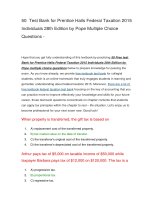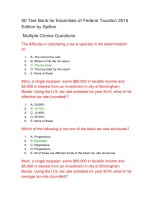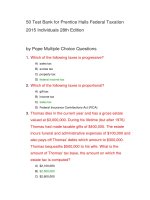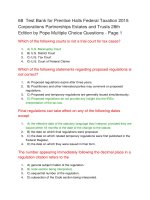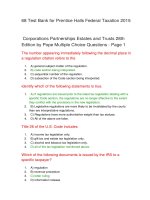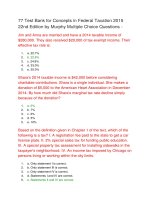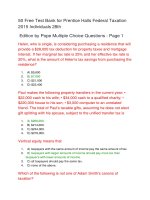104 test bank for concepts in federal taxation 2012 19th edition
Bạn đang xem bản rút gọn của tài liệu. Xem và tải ngay bản đầy đủ của tài liệu tại đây (200.53 KB, 34 trang )
Test Bank for Concepts in Federal Taxation 2012
19th Edition
True-False Questions
All tax practitioners are governed by the AICPA’s Code of
Professional Conduct.
1.
True
2.
False
A regressive tax rate structure is defined as a tax in which the
average tax rate decreases as the tax base increases.
1.
True
2.
False
Self-employed people are required to make quarterly payments
of their estimated tax liability.
1.
True
2.
False
The marginal tax rate is the rate of tax that will be paid on the
next dollar of income or the rate of tax that will be saved
by the next dollar of deduction.
1.
True
2.
False
Employers are required to pay a Federal Unemployment Tax of
6.2% of the first $10,000 in wages to each employee less a
credit of up to 5.4% of state unemployment taxes paid.
1.
True
2.
False
Adam Smith identified efficient, certainty, convenience, and
economy as the four basic requirements for a good tax
system.
1.
True
2.
False
Congress is required to insure that the tax law has the following
characteristics: equality, certainty, convenience, and
economy.
1.
True
2.
False
The statute of limitations is three years, six years if the taxpayer
omits gross income in excess of 25%, and there is no
statute of limitations if the taxpayer willfully defrauds the
government.
1.
True
2.
False
A deferral is like an exclusion in that it does not have a current
tax effect, but it differs in that an exclusion is never
subject to taxation, whereas a deferral will be subject to
tax at some point of time in the future.
1.
True
2.
False
Tax avoidance occurs when a taxpayer uses fraudulent
methods or deceptive behavior to hide actual tax liability.
1.
True
2.
False
A tax is an enforced contribution used to finance the functions
of government.
1.
True
2.
False
An annual loss results from an excess of allowable deductions
for a tax year over the reported income.
1.
True
2.
False
Gifts to qualified charitable organizations may be deducted as a
contribution, but not to exceed 50% of an individual
taxpayer’s adjusted gross income.
1.
True
2.
False
Horizontal equity exists when two similarly situated taxpayers
are taxed the same.
1.
True
2.
False
A CPA may prepare tax returns using estimates provided by the
taxpayer if it is impracticable to obtain exact data and the
estimates are reasonable.
1.
True
2.
False
Multiple Choice Questions-Page 1
Which of the following are included among Adam Smith's
criteria for evaluating a tax? I. Convenience. II. Fairness.
III. Neutrality. IV. Economy.
1.
Statements I and II are correct.
2.
Statements I, II, and III are correct.
3.
Statements I and IV are correct.
4.
Statements II and III are correct.
5.
Statements I, II, III, and IV are correct.
Adam Smith's concept of vertical equity is found in a tax rate
structure that is
1.
Regressive.
2.
Proportional.
3.
Horizontal.
4.
Progressive.
5.
Economical.
Which of Adam Smith's requirements for a good tax system
best supports the argument that the federal income tax
rate structure should be progressive?
1.
Certainty.
2.
Convenience.
3.
Equality.
4.
Neutrality.
5.
Sufficiency.
When planning for an investment that will extend over several
years, the ability to predict how the results of the
investment will be taxed is important. This statement is an
example of
1.
Certainty.
2.
Transparency
3.
Equality.
4.
Neutrality.
5.
Fairness.
Jim and Anna are married and have a 2011 taxable income of
$280,000. They also received $20,000 of tax-exempt
income. Their effective tax rate is:
1.
22.7%
2.
23.3%
3.
24.9%
4.
33.0%
5.
35.0%
Which of the following statement is/are included in Adam
Smith’s four requirements for a good tax system? I.
Changes in the tax law should be made as needed to raise
revenue and for proper administration. II. A tax should be
imposed in proportion to a taxpayer's ability to pay. III. A
taxpayer should be required to pay a tax when it is most
likely to be convenient for the taxpayer to make the
payment. IV. The government must collect taxes equal to
it’s expenses.
1.
Statements I and II are correct.
2.
Statements I and IV are correct.
3.
Statements II and III are correct.
4.
Statements II and IV are correct.
5.
Statements III and IV are correct.
Jessica is single and has a 2011 taxable income of $199,800.
She also received $15,000 of tax-exempt income.
Jessica's marginal tax rate is
1.
22.8%
2.
23.3%
3.
25.0%
4.
28.0%
5.
33.0%
Which of the following payments would not be considered a
tax?
1.
An assessment based on the selling price of the vehicle.
2.
A local assessment for new sewers based on the amount of water used.
3.
A local assessment for schools based on the value of the taxpayer's property.
4.
A surcharge based upon the amount of income tax already calculated.
Which of the following payments meets the IRS definition of a
tax?
1.
A fee paid on the value of property transferred from one individual to another by gift.
2.
A one-time additional property tax assessment to add a sidewalk to the neighborhood.
3.
A fee paid on the purchase of aerosol producing products to fund ozone research.
4.
A fee for a sticker purchased from a city that must be attached to garbage bags before
the city garbage trucks will pick up the bags.
5.
All of the above meet the definition of a tax.
Based on the definition given in Chapter 1 of the text, which of
the following is a tax? I. A registration fee paid to the state
to get a car license plate; II. 2% special sales tax for
funding public education; III. A special property tax
assessment for installing sidewalks in the taxpayer's
neighborhood; IV. An income tax imposed by Chicago on
persons living or working within the city limits.
1.
Only statement I is correct.
2.
Only statement III is correct.
3.
Only statement IV is correct.
4.
Statements I and IV are correct.
5.
Statements II and IV are correct.
Terry is a worker in the country Pretoria. His salary is $46,000
and his taxable income is $52,000. Pretoria imposes a
Worker Tax as follows: Employers withhold a tax of 20%
of all wages and salaries. If taxable income as reported on
the employee's income tax return is greater than $50,000,
an additional 10% tax is withheld on all income. Terry's
marginal tax rate is:
1.
0%
2.
10%
3.
20%
4.
30%
Andrea is single and has a 2011 taxable income of $199,800 She
also received $15,000 of tax-exempt income. Andrea's
average tax rate is
1.
22.8%
2.
23.3%
3.
25.4%
4.
28.5%
5.
33.0%
Which of the following payments is a tax? I. Artis paid the IRS a
penalty of $475 (above his $11,184 income tax balance
due) because he had significantly underpaid his
estimated income tax; II. Lindsey paid $135 to the State of
Indiana to renew her CPA license' III. Carrie paid a $3.50
toll to cross the Mississippi River; IV. Darnell paid $950 to
the County Treasurer's Office for an assessment on his
business equipment.
1.
Only statement IV is correct.
2.
Only statement III is correct.
3.
Statements II and IV are correct.
4.
Statements I, II, and III are correct.
5.
Statements I, II, III, and IV are correct.
Maria is single and has a 2011 taxable income of $200,000. She
also received $15,000 of tax-exempt income. Maria's
effective tax rate is:
1.
22.8%
2.
23.7%
3.
25.0%
4.
28.0%
5.
33.0%
If a taxpayer has a choice of receiving income in the current
year versus the following year, which of the following tax
rates is important in determining the year in which he
should include the income?
1.
Average.
2.
Effective.
3.
Composite.
4.
Marginal.
Bob and Linda are married and have a 2011 taxable income of
$280,000. They also received $20,000 of tax-exempt
income. Their marginal tax rate is:
1.
23.5%
2.
24.9%
3.
28.0%
4.
33.0%
5.
35.0%
Vertical equity: I. means that those taxpayers who have the
greatest ability to pay the tax should pay the greatest
proportion of the tax. II. means that two similarly situated
taxpayers are taxed the same. III. is reflected in the
progressive nature of the federal income tax system. IV.
exists when Avis, a single individual with 4 dependent
children, and Art, a single individual with no dependents,
both pay $2,400 income tax on equal $26,000 annual
salaries.
1.
Statements III and IV are correct.
2.
Statements II and III are correct.
3.
Statements I and III are correct.
4.
Only statement IV is correct.
5.
Statements I, II, III, and IV are correct.
According to the IRS definition, which of the following is not a
characteristic of a tax?
1.
The payment to the governmental authority is required by law.
2.
The payment relates to the receipt of a specific benefit.
3.
The payment is required pursuant to the legislative power to tax.
4.
The purpose of requiring the payment is to provide revenue to be used for the public or
governmental purposes.
Which of the following payments meets the IRS definition of a
tax?
1.
Sewer fee charged added to a city trash collection bill.
2.
A special assessment paid to the county to pave a street.
3.
A levy on the value of a deceased taxpayer's estate.
4.
Payment of $300 to register an automobile. The $300 consists of a $50 registration fee
and $250 based on the weight of the auto.
Horizontal equity: I. means that those taxpayers who have the
greatest ability to pay the tax should pay the greatest
proportion of the tax. II. means that two similarly situated
taxpayers are taxed the same. III. is reflected in the
progressive nature of the federal income tax system. IV.
exists when Avis, a single individual with 4 dependent
children, and Art, a single individual with no dependents,
both pay $2,400 income tax on equal $26,000 annual
salaries.
1.
Statements III and IV are correct.
2.
Statements II and III are correct.
3.
Statements I and III are correct.
4.
Only statement IV is correct.
5.
Statements I, II, III, and IV are correct.
Pay-as-you-go withholding is consistent with Adam Smith's
criteria of
1.
Certainty.
2.
Convenience.
3.
Economy.
4.
Fairness.
5.
Transparency.
Jaun plans to give $5,000 to the American Diabetes Association.
Jaun's marginal tax rate is 28%. His average tax rate is
25%. Jaun's after-tax cost of the contribution is
1.
$1,250
2.
$1,400
3.
$3,600
4.
$3,750
5.
$5,000
Katie pays $10,000 in tax-deductible property taxes. Katie’s
marginal tax rate is 25%, average tax rate is 24%, and
effective tax rate is 20%. Katie's tax savings from paying
the property tax is:
1.
$ 1,600
2.
$ 2,000
3.
$ 2,400
4.
$ 2,500
5.
$10,000
Frank and Fran are married and have a 2011 taxable income of
$280,000. They also received $20,000 of tax-exempt
income. Their average tax rate is:
1.
23.2%
2.
24.9%
3.
22.3%
4.
33.0%
5.
35.0%
83 Free Test Bank for Concepts in Federal Taxation
2012 19th Edition by Murphy Multiple Choice
Questions-Page 2
Katarina, a single taxpayer, has total income from all sources of
$100,000 for 2011. Her taxable income after taking into
consideration $25,000 in deductions and $10,000 in
exclusions is $65,000. Katarina’s tax liability is $12,375.
What are Katarina's marginal, average, and effective tax
rates?
1.
28% marginal; 19.0% average; 19.0% effective.
2.
25% marginal; 16.5% average; 16.5% effective.
3.
25% marginal; 16.5% average; 19.0% effective.
4.
25% marginal; 19.0% average; 16.5% effective.
5.
28% marginal; 16.5% average; 19.0% effective.
Greg pays sales tax of $7.20 on the purchase of a lamp for $120.
Michelle paid sales tax of $9 on the purchase of a similar
lamp for $150. Greg's taxable income for the current year
is $40,000. Michelle's taxable income is $55,000. I. The
structure of the sales tax is progressive if based on
taxable income. II. The structure of the sales tax is
proportional if based on sales price.
1.
Only statement I is correct.
2.
Only statement II is correct.
3.
Both statements are correct.
4.
Neither statement is correct.
The term "tax law" as used in your textbook includes: I.
Treasury regulations. II. College textbooks (i.e. “Concepts
in Federal Income Taxes”). III. Internal Revenue Code of
1986. IV. Tax related decisions of a U.S. Circuit Court of
Appeals.
1.
Only statement III is correct.
2.
Statements I, III, and IV are correct.
3.
Statements I and III are correct.
4.
Only statement II is correct.
5.
All four statements are correct.
Heidi and Anastasia are residents of the mythical country of
Wetland. Heidi pays $1,500 income tax on taxable income
of $6,000. Anastasia pays income tax of $21,000 on
taxable income of $72,000. The income tax structure is I.
Progressive. II. Proportional. III. Regressive. IV. Valueadded. V. Marginal.
1.
Only statement I is correct.
2.
Only statement II is correct.
3.
Only statement III is correct.
4.
Only statement V is correct.
5.
Statements II and IV are correct.
Sally is an electrician employed by Bogie Company. Sam is a
self-employed electrician. During the current year, Sally's
salary is $85,000 and Sam's net self-employment income
is $85,000. Which of the following statements about the
Social Security and self-employment taxes paid is/are
correct? I. Sam's self-employment tax is greater than the
Social Security tax paid on Sally's income. II. Sam and
Sally pay the same amount of tax
1.
Only statement I is correct.
2.
Only statement II is correct
3.
Both statements are correct
4.
Neither statement is correct
Jered and Samantha are married. Their 2011 taxable income is
$80,000 before considering their mortgage interest
deduction. If the mortgage interest totals $10,000 for 2011,
what are the tax savings attributable to their interest
deduction?
1.
$ 1,500
2.
$ 2,500
3.
$ 2,800
4.
$ 3,300
5.
$10,000
Employment taxes are
1.
revenue neutral.
2.
regressive .
3.
value-added.
4.
progressive.
5.
proportional.
How much additional Social Security tax does Elise pay in 2011
on her $10,000 Christmas bonus? Her total earnings for
the year (before the bonus) are $110,000.
1.
$0
2.
$ 145
3.
$ 620
4.
$ 765
How much additional Social Security tax does Betty pay in 2011
on her $10,000 Christmas bonus? Her total earnings for
the year (before the bonus) are $100,000.
1.
$145.00
2.
$269.20
3.
$566.60
4.
$641.00
5.
$765.00
Taxpayer A pays tax of $3,300 on taxable income of $10,000
while taxpayer B pays tax of $6,600 on $20,000. The tax is
a
1.
proportional tax.
2.
regressive tax.
3.
progressive tax.
4.
horizontal tax.
A tax provision has been discussed that would add an
additional marginal tax rate of 39% to be applied to an
individual's taxable income in excess of $800,000. If this
provision were to become law, what overall distributional
impact would it have on our current income tax system?
1.
Proportional.
2.
Regressive.
3.
Progressive.
4.
Disproportional.
5.
None of the above.
Lee's 2011 taxable income is $88,000 before considering
charitable contributions. Lee is a single individual. She
makes a donation of $10,000 to the American Heart
Association in December 2011. By how much did Lee's
marginal tax rate decline simply because of the
donation?
1.
0%
2.
10%
3.
3%
4.
5%
5.
8%
Rayburn is the sole owner of a dance studio. During the current
year, his net self-employment income from the dance
studio is $50,000. What is Rayburn 's self-employment
tax?
1.
$3,825.00
2.
$5,738.00
3.
$6,200.00
4.
$7,650.00
When property is transferred, gift and estate taxes are based on
the
1.
fair market value of the assets on the date of transfer.
2.
replacement cost of the transferred property.
3.
transferor's original cost of the transferred property.
4.
transferor's adjusted basis of the transferred property.
5.
fair market value less adjusted basis on the date of the transfer.
Oliver pays sales tax of $7.20 on the purchase of a lamp for
$120. Michelle paid sales tax of $9 on the purchase of a
similar lamp for $150. Oliver's taxable income for the
current year is $40,000. Michelle's taxable income is
$55,000. I. The structure of the sales tax is regressive if
based on taxable income. II. The structure of the sales tax
is proportional if based on sales price. III. The structure of
the sales tax is progressive based on taxable income. IV.
The average sales tax paid on a purchase eq
1.
Only statement I is correct.
2.
Only statement II is correct.
3.
Statements III and IV are correct.
4.
Statements II and IV are correct.
5.
Statements I, II, and IV are correct.
A property tax: I. is levied on the value of property. II. is referred
to as ad valorem. III. on personal property is more
common than a tax on real property. IV. is based upon
assessed value rather than actual transactions.
1.
Only statement I is correct.
2.
Statements II and III are correct.
3.
Statements I, II, and IV are correct.
4.
Statements I, II, III, and IV are correct.
Samantha is a self-employed electrician. During 2011, her net
self-employment income is $120,000. What is Samantha's
self-employment tax?
1.
$15,570.00
2.
$15,606.80
3.
$16,128.00
4.
$16,723.20
5.
$18,360.00
Joy receives a used car worth $13,000 from her uncle as a
graduation present. As a result of the gift: I. Joy will have
$13,000 of taxable income. II. Joy’s uncle’s gift will
subject him to the gift tax.
1.
Only statement I is correct.
2.
Only statement II is correct.
3.
Both statements are correct.
4.
Neither statement is correct.
The Federal income tax is a
1.
revenue neutral tax.
2.
regressive tax.
3.
value-added tax.
4.
progressive tax.
5.
form of sales tax.
Elrod is an employee of Gomez Inc. During 2011, Elrod receives
a salary of $120,000 from Gomez. What amount should
Gomez withhold from Elrod's salary as payment of Elrod's
social security and medicare taxes?
1.
$7,440.00
2.
$7,803.40
3.
$8,064.00
4.
$8,361.60
5.
$9,180.00
Alan is a single taxpayer with a gross income of $88,000, a
taxable income of $66,000, and an income tax liability of
$12,625. Josh also has $8,000 of tax-exempt interest
income. What are Alan's marginal, average, and effective
tax rates?
1.
25% marginal; 17.1% average; 19.1% effective.
2.
28% marginal; 15.9% average; 21.7% effective.
3.
28% marginal; 17.1% average; 21.7% effective.
4.
25% marginal; 19.1% average; 17.1% effective.
Phyllis is an electrician employed by Bogie Company. Phil is a
self-employed electrician. During the current year,
Phyllis's salary is $75,000 and Phil's net self-employment
income is $75,000. Which of the following statements
about the Social Security and self-employment taxes paid
is/are correct? I. Phil's self-employment tax is greater
than the Social Security tax paid on Phyllis's income. II.
Phil pays more self-employment tax than Phyllis pays in
Social Security tax. III. Phil and Phyllis pay the same
1.
Only statement I is correct.
2.
Only statement I is correct.
3.
Only statement IV is correct.
4.
Statements I and III are correct.
5.
Statements II and IV are correct.
Shara's 2011 taxable income is $42,000 before considering
charitable contributions. Shara is a single individual. She
makes a donation of $5,000 to the American Heart
Association in December 2011. By how much did Shara's
marginal tax rate decline simply because of the
donation?
1.
0%
2.
7%
3.
3%
4.
5%
5.
10%
An excise tax: I. is levied on the value of property. II. is levied on
the quantity of the product or service. III. differs from an
sale tax, because a sales tax is imposed on the value of
property.
1.
Only statement I is correct.
2.
Only statement II is correct.
3.
Statements I and II are correct.
4.
Statements II and III are correct.
5.
Statements I, II, and III are correct.
Sally is an electrician employed by Bogie Company. Sam is a
self-employed electrician. During the current year, Sally's
salary is $85,000 and Sam's net self-employment income
is $85,000. Which of the following statements about the
Social Security and self-employment taxes paid is/are
correct? I. Sam pays more self-employment tax than Sally
pays in Social Security tax. II. Sam's self-employment tax
is equal to the Social Security tax paid on Sally's income.
1.
Only statement I is correct.
2.
Only statement II correct.
3.
Both statements are correct.
4.
Neither statement is correct.
How much additional Social Security tax does Connie pay in
2011 on her $10,000 Christmas bonus? Her total earnings
for the year (before the bonus) are $42,000.
1.
$0
2.
$145.00
3.
$620.00
4.
$765.00
A state sales tax levied on all goods and services sold is an
example of a
1.
progressive tax.
2.
regressive tax.
3.
proportional tax.
4.
value added tax.
Which of the following types of taxes rely solely on "income" as
the tax base for determining the amount of tax liability? I.
Sales Tax; II. Property Tax; III. Gift Tax; IV. Social Security
Tax; V. Excise Tax
1.
Statements I, II, III, IV, and V are correct.
2.
Statements I, III, and IV are correct.
3.
Statements II and IV are correct.
4.
Only statement IV is correct.
5.
None of the above types of taxes relies on income for its tax base.
Marie earns $80,000 as a sales manager for Household Books.
How much Social Security and medicare tax does Marie
have to pay?
1.
$ 4,960.00
2.
$ 6,120.00
3.
$ 6,400.00
4.
$12,240.00
83 Free Test Bank for Concepts in Federal Taxation
2012 19th Edition by Murphy Multiple Choice
Questions-Page 3
Betty hires Sam to prepare her federal income tax return. In
preparing the return, Sam erroneously decided to exclude
consulting fees because he estimated that Betty's
expenses should have exceeded the income she received.
If the IRS detects Betty's underpayment of tax, what is the
likely result? I. Betty is not subject to the negligence
penalty since she relied on a professional tax preparer
and reported her income in good faith. II. Sam is liable for
payment of Betty's tax due plus interest and negligenc
1.
Only statement I is correct.
2.
Only statement II is correct.
3.
Both statements are correct
4.
Neither statement is correct.
Trang is in the 15% marginal tax bracket in the current year. She
owes a $10,000 bill for business expenses. Since she
reports taxable income on a cash basis, she can deduct
the $10,000 in either this year or next year, depending on
when she makes the payment. She can pay the bill at any
time before January 31 of next year, without incurring the
normal 12% interest charge. She expects to be in the 25%
marginal bracket next year. Without considering the time
value of money, what are her tax savings if she p
1.
Current year $1,000.
2.
Current year $1,500.
3.
Next year $1,000.
4.
Next year $2,500.
5.
Next year $1,500.
Based on the following information, what is the 2011 taxable
income for a married couple with two children? Total
income $120,000; Excludable income 2,000; Deductions
for AGI 5,000; Allowable itemized deductions 8,000
1.
$ 79,000
2.
$ 86,600
3.
$ 87,000
4.
$ 90,200
5.
$112,000.
Tax planning involves the timing of income and deductions.
General rules of thumb to follow when planning include: I.
putting income into the year with the lowest marginal tax
rate. II. deferring recognition of income.
1.
Only statement I is correct.
2.
Only statement II is correct.
3.
Both statements are correct.
4.
Neither statement is correct.
Tax planning involves the timing of income and deductions.
General rules of thumb to follow when planning include: I.
deferring recognition of income. II. putting deductions
into the year with highest marginal tax rate.
1.
Only statement I is correct.
2.
Only statement II is correct.
3.
Both statements are correct.
4.
Neither statement is correct.
The income tax formula for individual taxpayers is unique in
that deductions are broken into classes: I. This dichotomy
of deductions results in an intermediate income number
called adjusted gross income (AGI). II. One class of
deductions is called exclusions from income. III. One
class of deductions is called deductions for adjusted
gross income. IV. Expenses qualifying as deductions for
adjusted gross income are not limited by the income of
the taxpayer.
1.
Statements III and IV are correct.
2.
Statements II and III are correct.
3.
Statements I, III and IV are correct.
4.
Only statement IV is correct.
5.
Statements I, II, III, and IV are correct.
Tax evasion usually involves certain elements. Which of the
following are elements necessary for tax evasion to
occur? I. Nondisclosure of the relevant facts on the
taxpayer’s tax return. II. Underpayment of tax. III. Avoiding
detection by the IRS. IV. Willfulness on the part of the
taxpayer. V. An affirmative act by the taxpayer to
misrepresent.
1.
Statements I, II, and III are correct.
2.
Statements I, II, IV, and V are correct.
3.
Statements I and III are correct.
4.
Only statement IV is correct.
5.
All of the five listed elements are correct.
Betty hires Sam to prepare her federal income tax return. In
preparing the return, Sam erroneously decided to exclude
consulting fees because he estimated that Betty's
expenses should have exceeded the income she received.
If the IRS detects Betty's underpayment of tax, what is the
likely result? I. Betty is not subject to the negligence
penalty since she relied on a professional tax preparer
and reported her income in good faith. II. Betty is liable for
payment of the tax due plus interest and a negligenc
1.
Only I is correct.
2.
Only II is correct.
3.
Only III is correct.
4.
I and III are correct.
5.
I and IV are correct.
Sonya owes a deductible expense that she can pay either (and
deduct) this year or next year. She is in the 25% marginal
tax rate bracket. Which of the following statements about
this payment is/are correct? I. Deductions should always
be taken as soon as possible. Sonya should pay the
expense this year. II. If Sonya expects to be in the 28%
marginal tax rate bracket next year, she should pay the
expense this year. III. If Sonya expects to be in the 15%
marginal tax rate bracket next year, she should pay th
1.
Only statement II is correct.
2.
Only statement IV is correct.
3.
Statements I and III are correct.
4.
Statements I and IV are correct.
5.
Statements III and IV are correct.
For 2011, Nigel and Lola, married taxpayers without children,
calculated their total allowable itemized deductions to be
$17,100. Accordingly, Nigel and Lola file jointly and
should deduct from adjusted gross income: I. the
standard deduction amount of $11,600. II. total itemized
deductions equal to $17,100. III. one personal and one
dependency exemption amount. IV. exemption amounts
totaling $7,400.
1.
Only statement I is correct.
2.
Statements I and IV are correct.
3.
Statements I, III, and IV are correct.
4.
Statements II and IV are correct.
5.
Statements I, II, III, and IV are correct.
Which of the following are types of IRS examinations? I.
Information matching program. II. Office examination. III.
Field examination. IV. Revenue agent report.
1.
Statements II and III are correct.
2.
Only statement III is correct.
3.
Statements I and IV are correct.
4.
Statements I, II and III are correct.
5.
Only statement II is correct.
Tax planning involves the timing of income and deductions.
General rules of thumb to follow when planning include: I.
putting income into the year with the lowest marginal tax
rate. II. deferring deductions.
1.
Only statement I is correct.
2.
Only statement II is correct.
3.
Both statements are correct.
4.
Neither statement is correct.
The return selection program designed to select returns with
the highest probability of errors is
1.
The TCMP.
2.
The DIF program.
3.
The special audit program.
4.
The document perfection program.
5.
The information-matching program.
Ordinary income is: I. the common type of income that
individuals and businesses earn. II. receives no special
treatment under tax laws. III. the character of the gain
from the sales of shares of stock. held more than one
year
1.
Only statement I is correct.
2.
Only statement II is correct.
3.
Statements I and II are correct.
4.
Statements I and III are correct.
5.
Statements I, II, and III are correct.
All tax practitioners who prepare tax returns for a fee are
subject to which of the following? I. IRS Circular 230. II.
AICPA Code of Professional Conduct. III. Statements on
Standards for Tax Services. IV. American Bar Association
Code of Professional Conduct
1.
Only statement I is correct.
2.
Statements I, II, and III are correct.
3.
Statements II and III are correct.
4.
Statements II and IV are correct.
5.
Statements I, II, III, and IV are correct.
